Ford Fiesta ST (2018-2022) long-term test
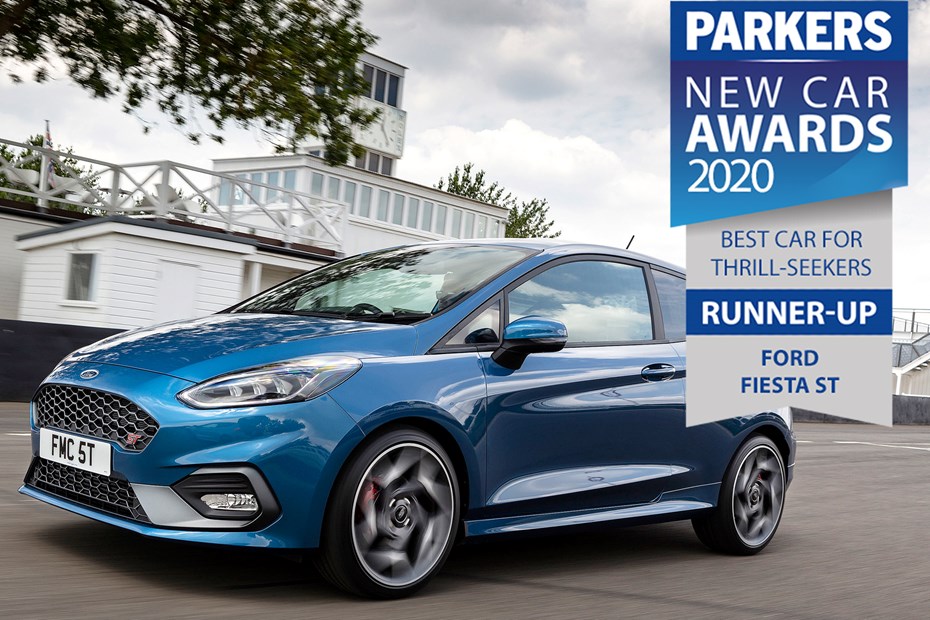
Update 1: Welcome
James Dennison takes delivery and runs our 2019 Thrill-Seekers’ car of the year…
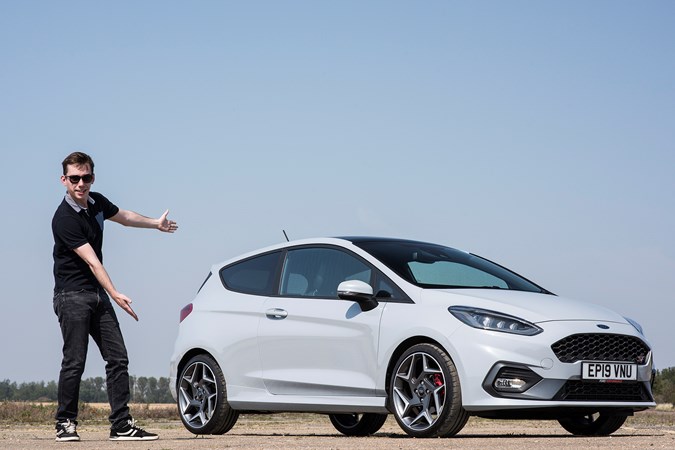
Back in 2018, we gave the Ford Fiesta ST the highly coveted Parkers Car of the Year award on the basis that there was/is no better way of spending £20k-odd on a new car. A bold claim, yes, but one that we (or rather, I) intend to prove or disprove by running said Fiesta ST for the next six months. Were we right to give it our top going, or did we get swept away on a tidal wave of hot-hatch hooliganism?
The exact version we’ve gone for is a top spec 3dr ST-3 finished in Silver Fox metallic grey paint. To these eyes, it’s a superb mix of subtle menace and svelte sophistication, with no doubts in my mind that it is better looking than the previous version – despite many opinions to the contrary.
Standard equipment is plentiful and includes climate control, Ford’s SYNC 3 Navigation system with an 8.0-inch touchscreen (plus Apple CarPlay and Android Auto), cruise control keyless entry and keyless start, heated front seats and steering wheel, a rear-view camera and Recaro leather sports seats. A long list indeed, but we’ve also added the openable panoramic sunroof, B&O sound system and, all importantly, the Performance Pack.
Said option adds launch control, performance shift indicators and a Quaife Limited Slip Differential. I’m sceptical as to how important the first two extras will be, but the latter should add to the Fiesta ST’s already startling levels of agility, but giving more traction coming out of tight corners.
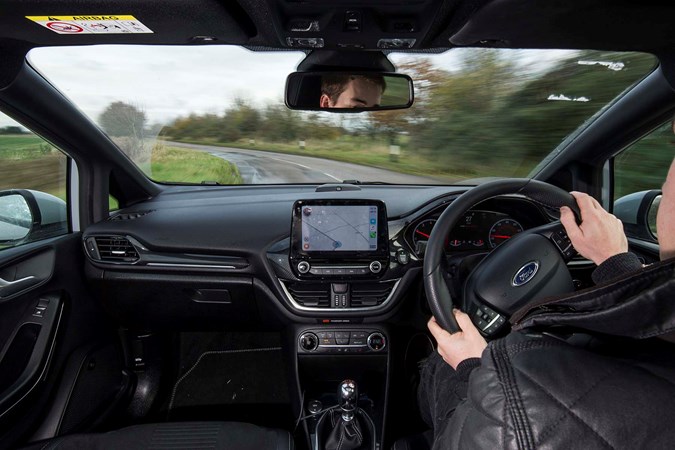
All Fiesta STs get a 1.5-litre three-cylinder engine producing 200hp and 290Nm of torque, enough to launch the car from 0-62mph in just 6.5 seconds and onto a top speed of 144mph. Not bad for a car with less cylinders than a Morris Marina…
The theme here, is that the Fiesta ST sounds undoubtedly good on paper (especially when you consider the base price of a 3-door ST-3 is just £22,450), and we know it’s superb fun to drive. But, if you’re going to buy one, there’s a good chance it’ll be used as a daily driver, and we all know that fun and well-priced doesn’t necessarily translate into ‘easy to live with on a day-to-day basis’.
Hence why, over the next six months, the thrill-a-minute Fiesta ST is going to be subjected to, among other things, my 200-mile round-trip daily commute, countless trips into central London and a 2,500-mile marathon trip to John O’Groats, taking in the best roads that Scotland has to offer.
At the end of the six months, I will give the definitive answer on whether you really can live with a performance-focused supermini and if there is in fact, a better way to spending £20,000 on a new car.
Tune in next month for the Fiesta ST’s running in trip to… Scotland!
Mileage: 457
Fuel economy: 40.4mpg (claimed)
Update 2: Driving and performance – road trip to Scotland
James takes his brand new Fiesta ST on a lap of Scotland
Road trips are a rite of passage for us petrolheads. A time for man and machine to bond over great roads, ‘pumping’ playlists (that means plenty of James Blunt in my case) and the freedom of simply being able to drive wherever one chooses.
Naturally, then, when the opportunity arose for me to take my box-fresh Fiesta ST up to Scotland for a few days, I didn’t give it a second thought. Joining me for the drive would be a couple of good mates from university, driving their lightning-quick 2017 Honda Civic Type R and – slightly ropey – 2005 BMW 330Ci respectively. Capable cars, but I reckoned the less-powerful Fiesta was the connoisseur’s choice.
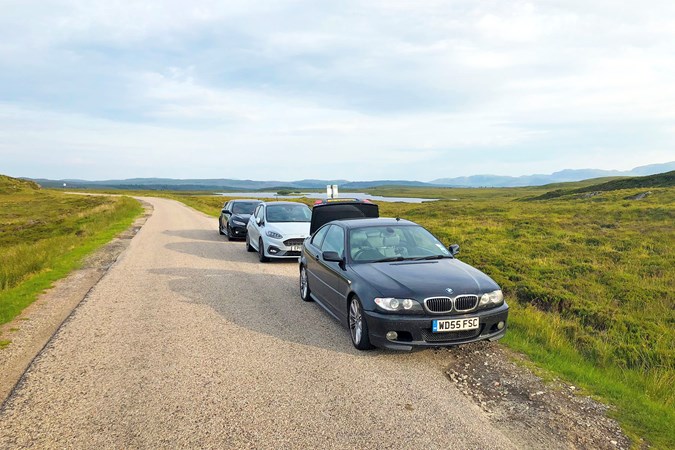
As soon as it was run in, that was. See, I was keen to make sure my Fiesta ST long-termer was given the best possible treatment in its first few hundred miles. That meant no revving it above 4,000rpm, no full bore gearchanges and no using the launch control function.
Sound dull? You’d be surprised. The sheer agility and whippet-like reflexes of the Fiesta ST meant that I seldom had to brake for corners. Scotland is plastered with narrow, but well-sighted roads and the ST’s ability to turn in on a sixpence, swivel slightly (maybe more than slightly) on its axis and then claw its way out of a corner was deeply impressive.

Such restrictions didn’t last long, though. As the odometer ticked through the magic marker, the full power of the 1.5-litre Ecoboost engine could finally be unleashed by my (now very impatient) right foot. Boy did it feel good ditching the minicabber gearshift strategy.
At this point, you’re probably expecting me to wax lyrical about how being able to use the full revs transformed the car. But honestly, it didn’t. Sure, it was an improvement (especially since I didn’t need to keep an eye on the revs on down changes), but the magic of the car lies in the chassis, rather than the engine. That’s not to say it’s not a superb power unit (the smooth, ludicrously torquey delivery is so nice to use in everyday driving), but it doesn’t fizz in the same way the chassis does. Maybe it’ll come alive the more I drive the car.

There’s no doubting how quick it is, though. Say ‘three-cylinder’ to any car enthusiast and they’ll likely think of cheap, economical hatchbacks with engines downsized to the point that they have more in common with a motorised pencil sharpener. And for the most part, that’s fairly accurate. Yet the engineers at Ford have managed to tease out some genuine speed form the little triple in the Fiesta ST. No, it’s not as punchy in the Type R in our convoy, but then it’s not a million miles off it either.
One way it does trump nearly every other performance car, however, (and I apologise in advance for bringing this up, but it is very impressive) is fuel economy. Yep, you read it right. This 200hp, 0-62mph in 6.7 seconds Ford Fiesta ST did the Scotland to London trip (539 miles) in exactly nine hours, averaging a faintly ridiculous 49.4mpg. Not to mention the fact the engine had only just been run in. I know, I’ve managed to end an exciting road trip to Scotland on a boring note, but rest assured, normal exciting service will be resumed next month.
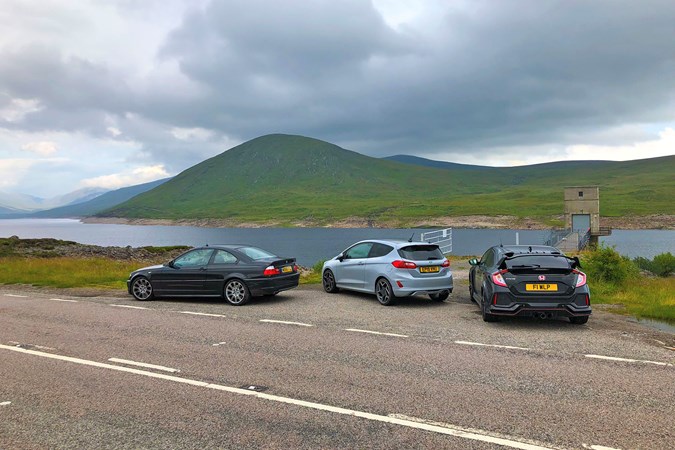
Mileage: 2,557
Fuel economy: 34.7mpg
Photo credits – Will Porter and Edmund Bannister
Update 3 – Interior and equipment
Britain’s bestselling supermini provides the perfect platform for hot-hatch buffoonery
You know, put aside all the Ford Performance heritage and grin-inducing handling capabilities of my current long-termer, and one of the best bits about it is… well, it’s a Fiesta. Sound strange? Bear with me.
See, the Ford Fiesta is Britain’s bestselling car – and there’s many reasons for this. Cheap to buy, cheap to run, fun to drive and stylish, it does everything a supermini needs to. The upshot of this is that the hot version (the ST), has a mighty good base to build on. It’s all very well adding Michelin Pilot Super Sport tyres, a Quaife limited-slip differential and launch control to a supermini, but if the standard car is poor then it’s appeal will always be limited. Not so with the Fiesta ST.
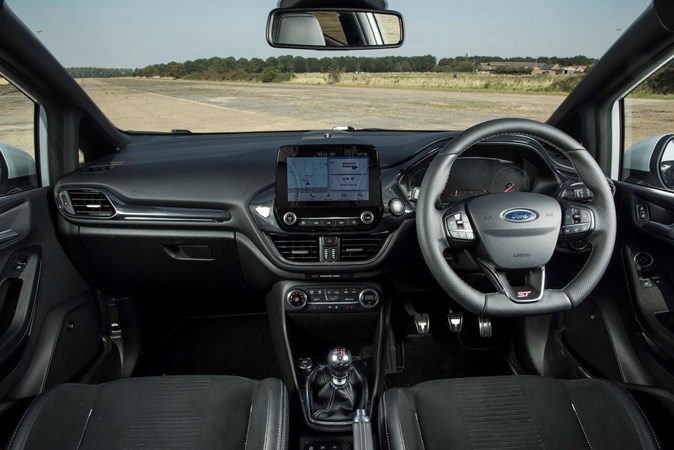
Well-judged interior
There’s nothing that really sets the ST’s cabin apart from the regular ST – and it’s all the better for it. Sure, you’ve got the figure-hugging Recaro seats (that hold you in place very well), sporty ST steering wheel and a few other embellishments, but that’s pretty much it.
Items such as the logically laid out physical air con switches, super clear dials and easy-to-understand infotainment system have barely been touched, allowing you to enjoy the Fiesta ST’s fun side without having to ‘put up’ with badly designed foibles. Sounds like it should be a given, but owners of Honda Civic Type Rs, Renault Megane RSs and Peugeot 308 GTIs will tell you that’s not the case. The Fiesta ST’s cabin won’t seem like a standout feature, yet it never takes anything away from the car’s best bits.
Particular highlights in my time with the car include the super-clear and easy-to-use physical climate control switches (again, not a given with a lot of new cars), do-what-it-says-on-the-tin dials and general storage space in and around the cabin (more on that in a later update).
Handy technology fitted as standard
This being an ST-3 Fiesta ST, much of the Fiesta’s broad range of clever technology comes included in the £23,995 (at the time of writing) on-the-road price. Goodies include:
- Traffic sign recognition & Auto High Beam – the latter is especially useful and one of the best examples of the tech I’ve tried on any car. Automatically activates high beam when the road is clear, quickly dips the lights when another car is detected ahead
- Keyless Entry and Keyless Ignition – you never need to take the key out of your pocket/bag. Unlocks as you put your hand on the door, locks by quickly holding your finger on the door handle
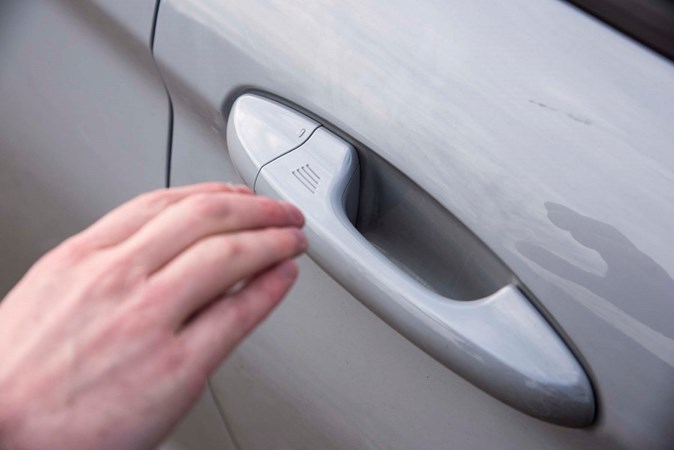
- Rear view camera with parking sensors – yes, it’s only a small car but if a small child runs behind you or there’s a hidden low bollard, the camera is mighty useful. Does need cleaning frequently, though
- Heated seats and steering wheel – I reckon the Fiesta’s heated seats are the most powerful in the business. Seriously, use with caution. The warmed steering wheel isn’t bad, either
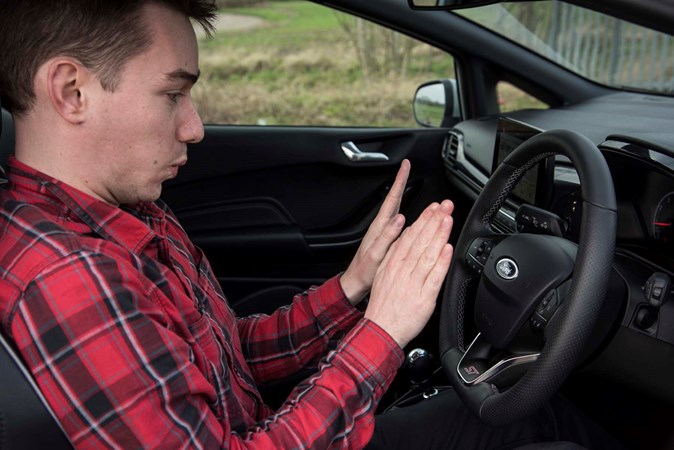
All is going well in Fiesta ST land, then.Tune in my next report on safety and practicality.
Report 4 – Practicality and safety
Chances are you won’t be buying a supermini-sized hot-hatchback for its practicality or safety, yet you never know when such things will become relevant. In the Fiesta ST’s case, it’s got both well-covered.
How much room is there?
Starting with practicality, there’s little difference between my ST long-termer and a regular three-door Fiesta, aside from the chunky Recaro seats that rob a little rear kneeroom. Space up front has been enough for myself and some very tall passengers (this does involve moving the seat back all the way, however), while storage room is also surprisingly generous.
I’ve taken to placing my water bottle in the side door pockets rather than the central cupholders as, like in many cars, taller items can get in the way of your natural arm movement when changing gear. Helpfully, said door pockets are deceptively large and can take two small water bottles at a pinch, plus a chunky sunglasses case.
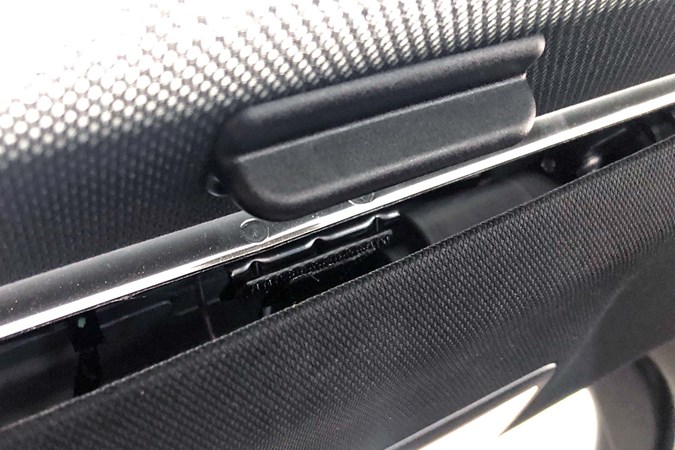
Climb into the back (you can get the ST as a five-door if threading yourself in-between the b-pillar and front seat proves too tricky) and passenger room is not far off what you get in a VW Polo. Just bear in mind that headroom takes a hit if you have the optional panoramic sunroof (like I do), while space for the middle seat passenger is tighter than in rivals. I’ve also noticed that the interior roof trim at the back is held in with what looks to be industrial-strength Velcro, which can come loose and rattle irritatingly.
How big is the boot?
At 311 and 1,093 litres with the seats in place and folded down respectively, the ST delivers the same boot space as regular Fiestas . More than enough, therefore, to fit a number of suitcases/camera equipment in. Not quite as big as a Polo GTI (355/1,125 litres), granted, but I’ve yet to feel that it’s not fit for purpose.
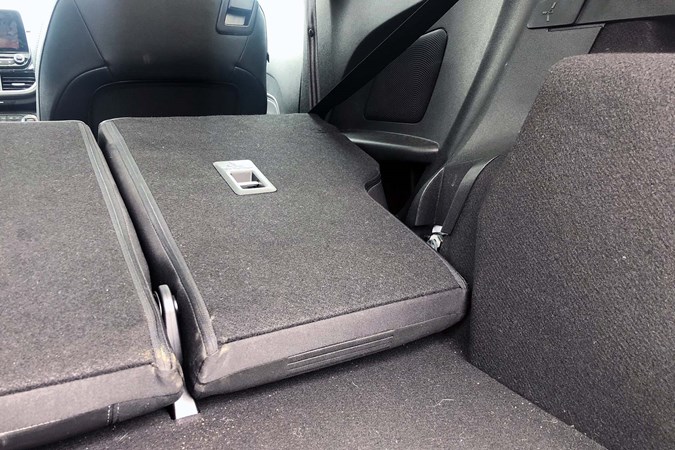
The only annoyance is that there’s a noticeable lip up from the boot floor to the backrests of the rear seats when folded down. This can be remedied by opting for the variable height boot floor, although this can’t be specced in tandem with the B&O sound system. However, I have heard a number of owners claim that this was previously available, so you may get lucky if buying used.
And the safety?
Working from a strong baseline thanks to the regular Fiesta’s five-star Euro NCAP safety rating, all ST’s get six airbags and what Ford calls the NCAP pack, including Lane-Keeping Alert and Lane-Keeping Aid, Speed Limiter, rear seatbelt minder, rear centre headrest and automatic headlamps. Upgrade to the ST-3 (like our long-termer) and additional kit includes traffic sign recognition, high-beam assist and a driver fatigue alert system.
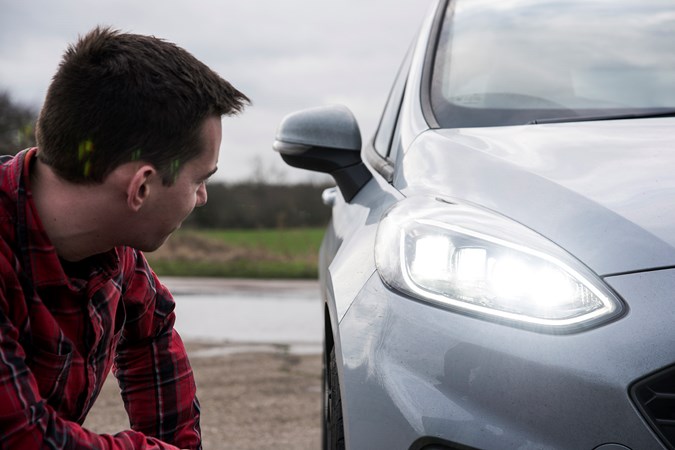
Of all the equipment, I never use the Lane-Keeping Aid (although the alert is useful), speed limiter and traffic sign recognition (it’s too unreliable), but the high-beam assist (which automatically activates when the dipped headlights are on and the road ahead is clear) is superb. Many cars have it, yet few are as impressive as the Fiesta ST’s system. Quick to activate and deactivate, I can’t remember the last time another drive flashed me for having them on too long. Plus, there’s not much that the already powerful LED headlamps can’t pick out on full beam.
Mileage: 5,915 miles
Fuel economy: 39.5 mpg
Report 5 – Is it perfect?
James has the unenviable task of trying to find fault with his beloved Fiesta ST long-termer
Regular readers of this page will know that I’m rather fond of the Fiesta ST. It’s quick, easy to use, relatively practical and it’s got some seriously powerful heated seats. What’s not to like? Well, actually, there are a couple of niggles that I feel duty-bound to highlight.
Overly bright reversing camera
In a trait that I share with Bono, Edgar Davids and Count Dracula, I’m not particularly fond of bright dashboard lights. Because of this – and to the chagrin of my colleagues – I always dim the instruments as far down as they go whatever car I’m in.
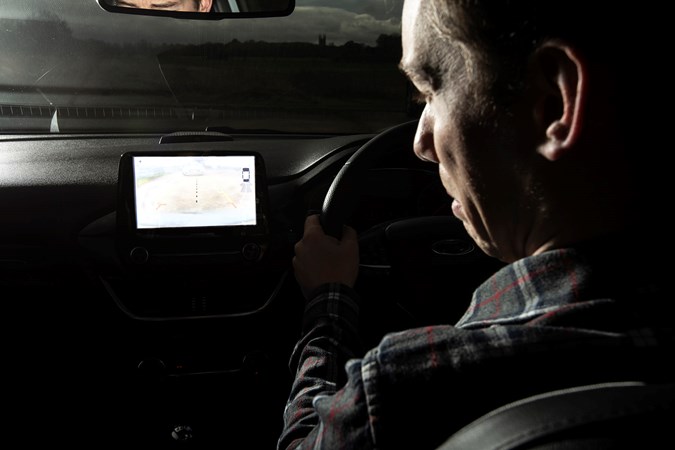
That’s no issue in the Fiesta ST. There’s a handy rocker switch down by the steering wheel that turns the lighting down quickly and easily. No faffing around in the infotainment system needed. However, such good work is undone immediately after I select reverse gear at night. Why? Well, the reversing camera always appears on the screen in its brightest setting regardless of how the rest of the instruments are set – presumably to make it more visible.
Ironically, though, all it does is blind my night vision when I glance at it to the point that I can no longer see the kerb when I then turn to look in the nearside mirror. And I’m not the only one that finds this a problem. Staff Writer Tom Wiltshire declared the Fiesta ST to be perfect in every way ‘apart from the dazzling reverse camera’ when he borrowed it late last year. If anyone knows of a way to change the reversing camera brightness, please let me know – Twitter handle is @JDennisonCars.
Auto Start-Stop only in Normal drive mode
Again, this is only a minor complaint but… The Fiesta ST is at its best in either Sport or Track mode – as you might expect from a feisty hot-hatch. So much so that, given the choice, I’d leave it in at least Sport as my default mode. The throttle response is much peppier, the steering just that bit weightier and it’s a more enjoyable car to drive.
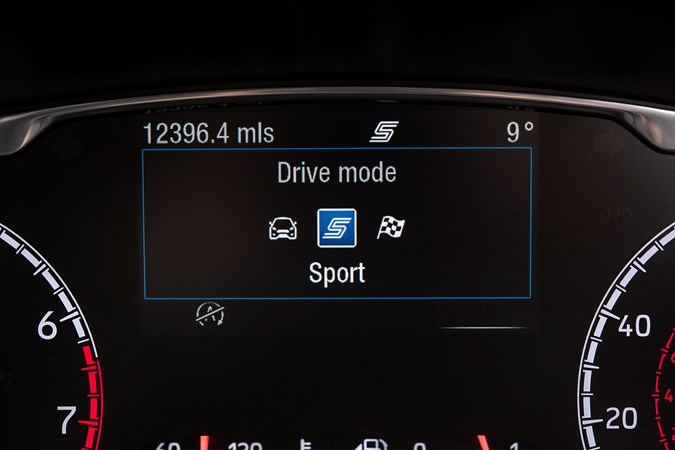
Sadly, though, when driving around town (an environment where you want snappy responses) I can’t really have it in Sport as the Auto Start-Stop is deactivated in anything but Normal mode. Otherwise I’d be wasting fuel and pouring out emissions while sitting at the million and one traffic lights there are in London. How’s that for nit-picking?
Truth is, that’s about it. I’m struggling to find any other issues. Really – the Fiesta ST is pretty much perfect for what it is. If you own one and disagree with my findings, or indeed have any more observations about the not-so perfect bits on the car, give us a shout on social media and let us know.
Mileage: 8,974 miles
Fuel economy: 39.7 mpg
Report 6 – Verdict
James says goodbye to the Ford Fiesta ST and gives you his verdict after 11,000 miles of motoring
Alas, my time with the Ford Fiesta ST has come to an end. And what a time it’s been. With the risk of giving the verdict away early, this has possibly been the finest long-term test car I’ve ever had the pleasure of running. I’m struggling to think of a situation where it hasn’t excelled beyond all reasonable expectations. So for those that have come here to convince yourself that you don’t need a Fiesta ST in your life, look away now…
Why you should consider the Fiesta ST
It’s incredible fun
One of the most common complaints about new performance cars is that that they’re too fast and too capable to actually have any fun with on the public road. When 0-62mph comes up in less than five seconds, silly speeds (and potential points on your licence) are mere seconds away. The Fiesta ST has no such issues.
Sure, it’s still plenty quick enough (0-62mph arrives in just 6.7 seconds), but you can put your foot down safe in the knowledge that there’s enough time before things start to get crazy. In fact – and this might not please everyone – the pops and bangs of the exhaust are far more prominent when driving at a brisk, but still reasonable pace.
Then, there’s the three-cylinder engine. It’s a revelation. Before the car was launched, few predicted that it would turn out this well, and while it’s not as buzzy or responsive as the four-cylinder 1.6-litre in the previous gen car, it’s still a strong, revvy unit with ample feelgood factor. The gearbox, too, is a satisfying and easy to use, even if the throw could be shorter.
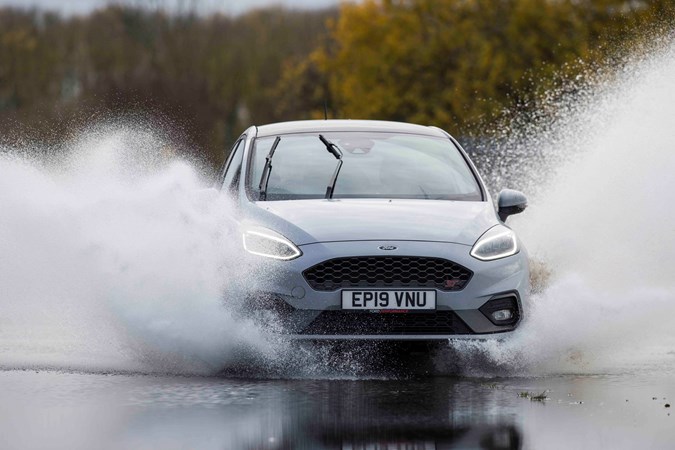
I’ve also enjoyed the size of the car. British country roads don’t tend to be that wide, so while a 600hp supercar with a singing V10 engine might sound like a dream scenario, the sheer width of such a vessel can make driving them a palm-sweating experience. Again, not something that ever concerned me in the Fiesta. It’s narrower than a Polo GTI and pretty much the same width as a Suzuki Swift Sport. And while those ‘Shrek ear’ wing mirrors might be small, they never feel exposed or vulnerable when nipping through tight spaces.
It can do sensible things, too
Driving enthusiastically down country roads is great, but when this is your only car, you want it to perform on the daily commute as well, right? Well this is where the Fiesta ST pulls off perhaps its greatest trick. It’s still a fabulous daily driver.
My commute to the office is considerable: 100 miles there, 100 miles back. Mostly motorways, often filled with frustrating traffic jams. The stuff of nightmares, many would say. And yet, I never once lost patience with the Fiesta ST. Why? Well, apart from the poor turning circle (it’s a pain, but you get used to it), it doesn’t have any of the ‘quirks’ that you’d usually have to put up with in other performance cars.
The ride, while firm, is still perfectly acceptable. The Recaro seats are fantastic (although maybe a little narrow if you’re of a larger build), the controls logically laid out and the infotainment/equipment consistently useful. It just worked. From the red-hot seat and steering wheel heating, to the blindspot monitoring and perfectly judged autonomous emergency braking system (the latter never once falsely activated).
If you want greater practicality, a five-door version is available, but there’s still room for two average-size adults (three is unrealistic for anything but short journeys). Boot space is reasonably generous, but note that the Polo GTI does have greater capacity. The Fiesta ST-3’s annoyingly uneven boot floor with the rear seats folded down (see report four for more info) is also worth highlighting.
It’s reasonably priced
It comes across as flippant to say that a £20k-odd brand-new car is cheap – such an amount of cash is a huge outlay for the vast majority of us. However, in the context of other new cars currently on the market, the Fiesta ST comes out very well indeed.
Say for example, you’re buying on a PCP deal (as the majority of customers will). Ford’s finance deals are usually competitive and there’s cracking value on offer with the Fiesta ST (and that’s before we talk about any potential discounts that the manufacturer is known to offer).

An ST-2 model (with the all-important Performance Pack) comes in at less per month, with the same deposit, as a 100hp Vauxhall Corsa. Now of course, the Corsa will make a solid car for many buyers, and will no doubt be slightly cheaper to run and insure, but compared with the Fiesta ST’s reputation of being one of the finest new cars of the past five years (Parkers Car of the Year in 2019, no less) – it shines a spotlight on the Ford’s exceptional value.
Talking of running costs, my long-termer managed a hugely respectable 40.1mpg on the average fuel economy cycle – just 0.3mpg off it’s claimed figure. This means that for those doing 12,000 miles a year, fuel costs will work out at around £1,770 for every 12 months motoring. As far as new cars go, that’s the most fun you’ll get out of a relatively modest outlay in fuel.
Now, at this point, we’d usually make some counter arguments against buying the car in the interests of offering a balanced opinion. However, if a small hot-hatchback is what you’re after then there really aren’t any reasons (small niggles aside, see report five) why you shouldn’t – at the very least – consider the Fiesta ST. So instead, I’ve come up with a few things to watch out for when buying a Fiesta ST.
Before buying
The ST-2 spec version will do everything you need but be absolutely sure to spec the Performance Pack. It’s only a few hundred pounds extra but makes a big difference to how the car drives – much of this down to the Quaife limited-slip differential. However, if you do that, then you may as well opt for the ST-3, which comes with the pack and some nice additional features – think B&O sound system, keyless entry, extra safety kit and a rear-view camera.
You’ll also get smarter-looking 18-inch alloy wheels that are 1-inch larger than the ST-2’s. And, having tested both back-to-back, we reckon there’s very little difference when it comes to ride comfort between each wheel size.
As mentioned above, cars with the B&O sound system are not officially available with the variable height boot floor. However, many owners of early Fiesta ST examples have reported that their cars do indeed come with both, so be sure to fully investigate the possibilities before committing to a specific trim level.
The Fiesta ST runs on Michelin Pilot Super Sport tyres. Utterly fabulous in dry weather, but I’ve always felt that other tyres could offer more in the wet. And for what it’s worth, they are utterly hopeless in the snow and ice. With this in mind, it may be investing in a set of winter tyres if the budget allows.
When it comes down to it, though, anyone who’s able to call a Fiesta ST their own is a very lucky person indeed. It is, without doubt, one of the cars of the decade and has managed to improve on the incredibly high bar set by its predecessor. I wish I could just pick it up and run off with it…

Next up for me on the long-termer front is a Honda Civic Type R, so make sure you head over to see how I’m getting on with my 320hp hot-hatchback, and don’t forget to check out the rest of our long-term reviews.
Mileage: 11,237 miles
Fuel economy: 40.1mpg



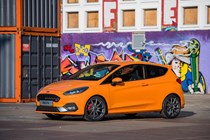
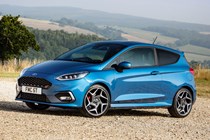
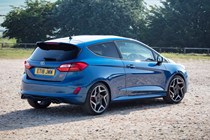
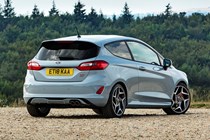
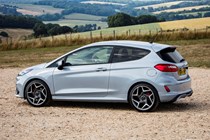
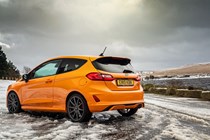
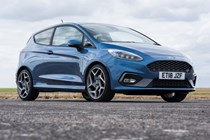
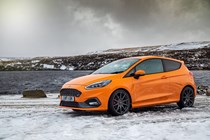
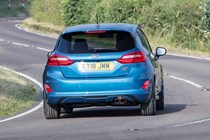
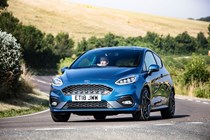
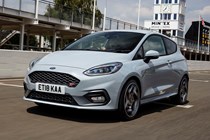
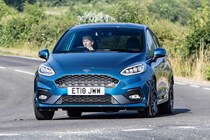
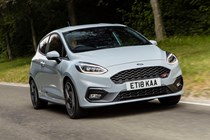
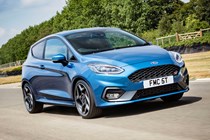

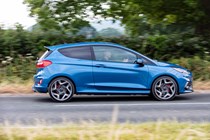
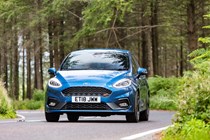
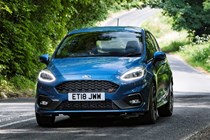
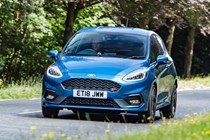
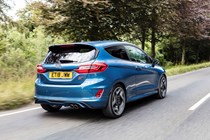
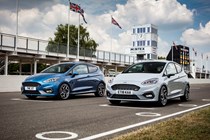
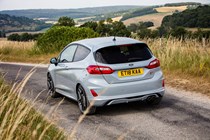
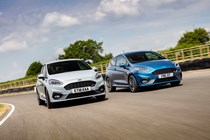
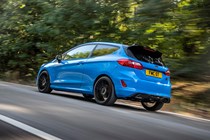
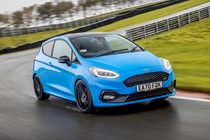
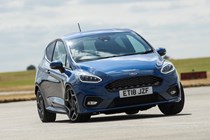
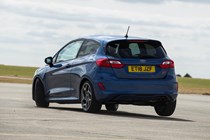
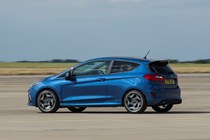

.jpg)
.jpg)
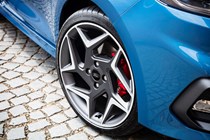
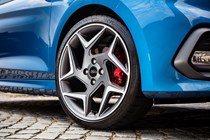
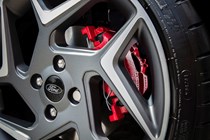
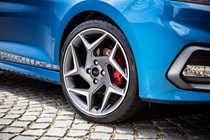
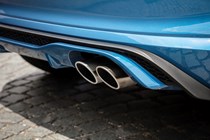
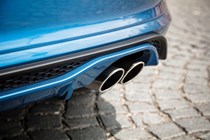
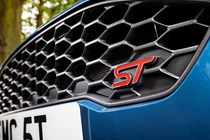
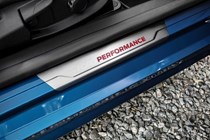
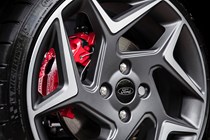
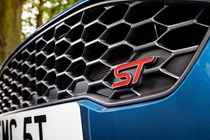
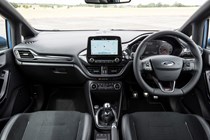
.jpg)
.jpg)
.jpg)
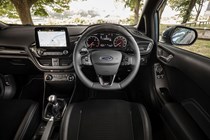
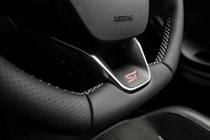
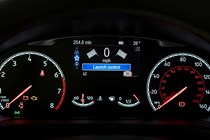
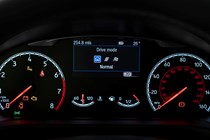

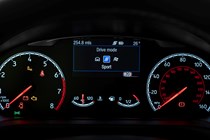
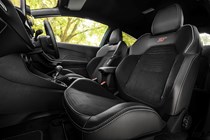
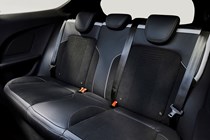
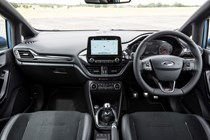
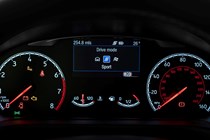
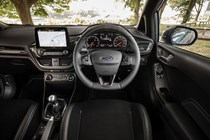
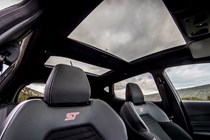
.jpg)
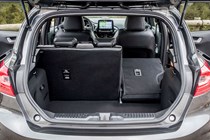
.jpg)

































.jpg?quality=50)
.jpg?quality=50)











.jpg?quality=50)
.jpg?quality=50)
.jpg?quality=50)












.jpg?quality=50)

.jpg?quality=50)
